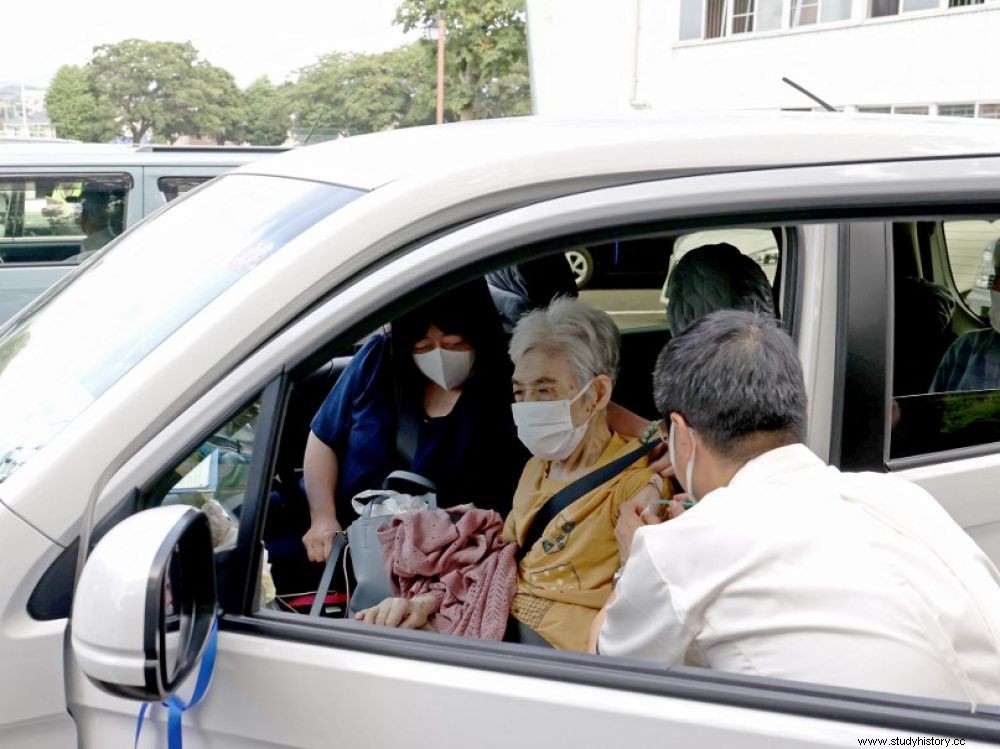ASIA PRESS REVIEW. Contents:three distinct populations, not two, are at the origin of the very first population of ancient Japan; this country, now undermined by its rapid aging, has every interest in developing the autonomous car; and finally Facebook, overtaken by American justice and ordered to collaborate in investigations into the Rohingya massacres in Burma in 2017.

In Mishima, Japan, an elderly person is vaccinated against Covid-19... The "press review" Asia of Sciences et Avenir of September 27 also shows the possible link between aging in the archipelago and the adoption that there could be of the autonomous car.
Paleogenetics never ceases to upset knowledge! Lately, it was the DNA analysis of very ancient human bones that upended what the Japanese knew about the very first inhabitants of their archipelago. The Japanese daily Asahi Shimbun reminds its readers that it was the anthropologist Kazuro Hanihara who proposed in 1991 a "double structure model" to explain the origins of the Japanese people. The modern population would have had for distant ancestors a people of gatherers-hunters-fishermen, at the origin of the Jomon civilization. These people who would have reached the archipelago of present-day Japan on foot came from the Asian continent. Around 3000 BCE, the Jomon people were gradually assimilated by new arrivals. This assimilation inaugurates the Yayoi period. This new influx of population is attributed to the importation of rice cultivation techniques and the casting of bronze and iron. The Jomon and Yayoi people were until now considered the first ancestors of the Japanese.
Paleogenetics never ceases to upset knowledge! Lately, it was the DNA analysis of very ancient human bones that upended what the Japanese knew about the very first inhabitants of their archipelago. The Japanese daily Asahi Shimbun reminds its readers that it was the anthropologist Kazuro Hanihara who proposed in 1991 a "double structure model" to explain the origins of the Japanese people. The modern population would have had for distant ancestors a people of gatherers-hunters-fishermen, at the origin of the Jomon civilization. These people who would have reached the archipelago of present-day Japan on foot came from the Asian continent. Around 3000 BCE, the Jomon people were gradually assimilated by new arrivals. This assimilation inaugurates the Yayoi period. This new influx of population is attributed to the importation of rice cultivation techniques and the casting of bronze and iron. The Jomon and Yayoi people were until now considered the first ancestors of the Japanese.

The analysis of the DNA of bones of 12 individuals belonging to the Jomon and Yayoi periods but also to the Kofun period (end of the 3rd to the 7th century of our era) by a team of Japanese-Irish scientists upsets this model and reveals a third migratory influx that occurred earlier. Paleogenomic analyzes have made it possible to compare the genetic heritage of these individuals belonging to the prehistory and protohistory of Japan. This comparison was made between the "Japanese" individuals but also with the genome of individuals from the Asian continent genetically close to the twelve skeletons. The existence of another genetic pool resulting from an Asian migration dating from the Kofun period has thus become evident to the researchers. It is a dogma that is being questioned, assures the daily Asahi .
"Understanding how disinformation started the genocide" :Facebook ordered to collaborate

Four years after the massacres and the Rohingya exodus to neighboring Bangladesh, Facebook has been ordered by American justice to deliver the content of blocked accounts, which would have peddled propaganda and messages of hatred against this Burmese community of obedience. Muslim in 2017. Facebook seems, according to this judge, to hinder investigations. The social network invokes the protection of the personal communications of its users in order not to deliver the content of the messages; according to the justice, their disclosure will make it possible to "understand how disinformation launched the genocide ".
In 2018, the American social network closed the accounts of Burmese soldiers who had openly participated in this disinformation campaign. Alongside this "official" cohort, closely linked to the power in place, there was also a nebula of fake accounts, created long ago by the military. These accounts initially claimed to be fans of local celebrities, or national heroes. Their remarks touched on all subjects, accumulating year after year thousands, even millions of sympathizers. The rhetoric gradually changed and aimed its virulence at the Rohingya.
The manipulation of information intensified from 2017, and pitted Buddhist groups against Muslim groups. Facebook had the ability to locate the owners of these accounts in 2018. The same year, the investigation of the daily The New York Times revealed that the tracing configured by the network geolocated the messages and their accounts from areas located outside the Burmese capital Naypyidaw, i.e. districts composed of residences and military barracks.
Facebook is so ubiquitous in the daily lives of Burmese people that most of the 23 million Internet users equate the social network with the Internet itself. In a country that has long been subject to censorship, it has taken over from the neighborhood tea room, an agora where the only reliable information is exchanged. But Facebook fell, despite itself, into the hands of a military junta expert in manipulating public opinion, an instrument of propaganda and hatred that turned against part of the Burmese people.
Aging Japan has a lot to gain from self-driving cars

Will self-driving vehicles end up being accepted faster in Japan than elsewhere? This is what we imagine after reading the article from Tech Wire Asia . In the archipelago, the interest in the autonomous car is not only conditioned by the search for an economic recovery or a consumerist enthusiasm for a technological novelty. According to Tech Wire Asia , another reason prevails:the Japanese demographic aging.
A recent report from the Japanese Ministry of Economy and Trade (METI), deciphered by the news site, is alarmed at the lack of upcoming drivers in the public transport and freight sectors. How to replace aging drivers, how to avoid accidents caused by employees who are no longer in possession of all their means? Buses, shuttles and autonomous trucks therefore seem to be an accessible solution. The country is investing massively in the technologies on which these vehicles are based (connected sensors, "machine learning" or automatic learning) and is also adopting a legal framework to admit this mode of transport in the public space.
The METI also plans forty test sites by 2025 for autonomous taxis. But on the side of Japanese public opinion, the vehicles still arouse a lot of mistrust as everywhere else in the world. An accident last month at the Paralympic Games in Tokyo involving a shuttle, not to mention incidents that took place elsewhere in Asia, are all obstacles to the social acceptance of the self-driving car in Japan. Far-from-perfect technology still has a long way to go as Japan's population ages at high speed.
